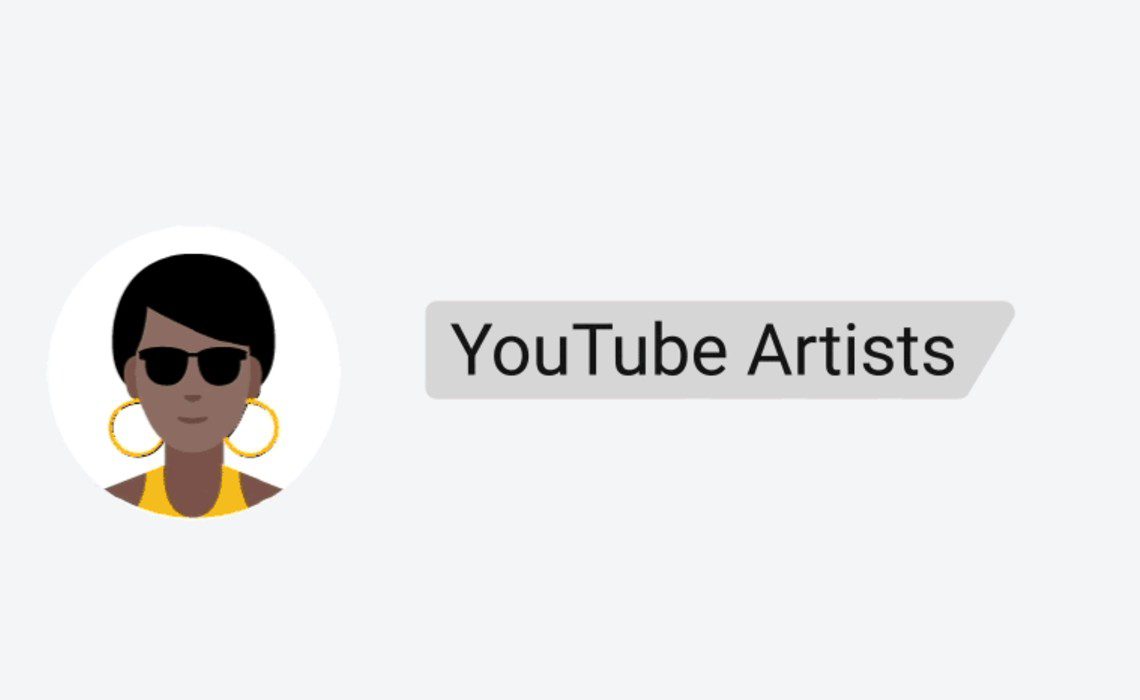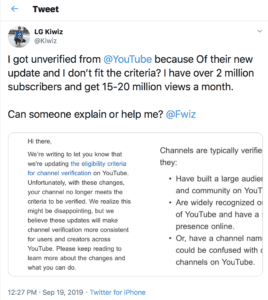YouTube has been fighting a credibility problem for quite some time. As I’ve been discussing on our blog, YouTube has struggled to keep its platform safe for advertisers. For example, YouTube’s reputation recently took a hit when businesses such as Disney and Nestle pulled their ads from the platform after a concerned YouTuber called attention to the number of predatory comments and videos targeting children. In response, YouTube terminated more than 400 channels and tens of millions of comments and then announced that it would ban comments completely for most videos of kids. YouTube is constantly in reactive mode, responding to a firestorm until a new one erupts. But YouTube is also trying to be more proactive, as witnessed by a new development: YouTube is changing its verification program for creators to make it harder for channels to earn a checkmark beside their name.
Initially YouTube also told content creators it would remove verification badges from people who don’t meet a stricter criteria to be verified. In doing so, YouTube created an enormous backlash among content creators, causing YouTube to quickly modify its approach. In the wake of the announcement and subsequent backpedaling, I can see why advertisers might be confused. Here’s what you need to know:
What Did YouTube Announce about Content Creation?
Google is changing the criteria by which a content creator can get a verification badge for their channel. On September 19, on its Creator Blog, YouTube wrote (in a post that was later amended), “We’ve updated the eligibility criteria for verification badges on YouTube. This change is to help viewers distinguish the official channel of a creator, celebrity, or brand. In the next weeks, verified channels will also get a new look. As a result of these changes, some channels that already have the verification badge will no longer meet the criteria to be verified. These channels received an email from YouTube with additional details.”
The changes were to take effect in October.
Why Is Verification Important?
For content creators, getting a verification badge next to their names is a big deal. As Google notes, if a channel has been verified, it’s the official channel of a creator, artist, company, or public figure on YouTube. Verified channels help distinguish official channels from other channels with similar names on YouTube.
Getting verified does not mean YouTube endorses your content, but it helps you with credibility and visibility. According to The Verge, “Being verified also represents status for creators. Having the checkmark beside their channel name is a sign of being one of the most prominent members of the community.”
How Is Verification Changing?
YouTube is going to make it tougher for a content creator to get the verification badge next to their name. Under YouTube’s current eligibility requirements, channels with more than 100,000 subscribers can be verified regardless of need for proof of authenticity. But as YouTube noted on its blog, “That worked well when YouTube was smaller, but as YouTube has grown and the ecosystem has become more complex, we needed a new way to verify the identity of channels and help users find the official channel they’re looking for.”
So, YouTube is instituting some more stringent requirements to get verified, along these lines:
- Authenticity: Does this channel belong to the real creator, artist, public figure, or company it claims to represent?
- Prominence: Does this channel represent a well-known or highly searched creator, artist, public figure, or company? Is this channel widely recognized outside of YouTube and have a strong presence online? Is this a popular channel that has a very similar name to many other channels?
YouTube notified a number of creators that their channels would lose verification status in October. The New York Times reported that YouTube had already sent emails to many content creators with the following message:
We’re writing to let you know that we’re updating the eligibility criteria for channel verification on YouTube. Unfortunately, with these changes, your channel no longer meets the criteria to be verified. We realize this might be disappointing, but we believe these updates will make channel verification more consistent for users and creators across YouTube.
Others received messages that their accounts would remain verified.
Why Is YouTube Changing its Verification Requirement?
YouTube wants to be more careful about how its algorithm recommends authentic video content from respected and high-profile content creators. YouTube has faced widespread criticism (including this highly cited article from The New York Times) that its algorithm recommends harmful content from extremists groups. YouTube has struggled to overcome a reputation for being a poorly moderated community – akin to being a town where a smelly garbage dump resides alongside a sparkling water park due to poor zoning and management. And advertisers don’t want their content in view of a garbage dump.
What Was the Fall-Out from the Verification Change?
Many content creators expressed outraged, as evidenced by this tweet from Kiwiz, an account with 2.34 million subscribers:
The New York Times reported many more howls of protests from content creators. Why, they asked, was YouTube pulling out the rug from beneath them after they had worked so hard to build their followings? Why was YouTube punishing individual artists?
As Caryn Marjorie Jones (CutieCaryn on YouTube) told The New York Times, “It’s just a little sign but it’s something I’ve worked years to get and to develop this fan base, so for it to be taken off was alarming and hurtful and I feel really emotionally impacted . . . I used my verification to set myself aside from everyone else. This could impact my business. Either people won’t think I’m legitimate or they won’t see me in the light they saw before. It will definitely affect my brand deals.”
As the impact of the new verification process became more widely felt, YouTube backed down on the evening of September 20. In a tweet, YouTube CEO Susan Wojcicki said, “We heard loud & clear how much the badge means to you. Channels that currently have verification will now keep it without appeal. We’ll continue reviewing those channels to ensure we’re protecting creators from impersonation.”
What Happens Next?
The process of getting YouTube verification is definitely going to get tougher. The more stringent process will probably have more of an impact on lesser known creators, such as micro-influencers. YouTube suggests that unverified creators do the following:
- Use a unique channel name that represents who you are and the type of content you publish.
- Use a high quality image for your channel icon to make your channel look professional in search results.
- Customize your channel art and layout for a personalized look and feel on your channel page.
Brands and artists with large YouTube followings, though, will benefit because presumably the more stringent verification process means fewer micro-influencers getting visibility.
What You Should Do
Although the more stringent verification is supposed to protect YouTube’s integrity, advertisers should still watch this development closer and hold YouTube accountable. Over time, your YouTube rep should be able to give you tangible examples of how the change has made YouTube a better home for advertisers. But be patient. Don’t assume the new program will have immediate results.
Consider also how the more stringent verification policy will affect your relationship with micro-influencers on YouTube. If you rely on micro-influencers to build your brand, be aware that some perfectly fine and appropriate micro-influencers might be flying under your radar screen even though they fail to meet the new criterion for getting a verification badge going forward.
Also, understand how YouTube will adapt its badging approach come 2020, which YouTube discusses here (basically, YouTube will distinguish between artists and content creators).
As always with the dynamic world of Google and its many brands, change is a constant. Be vigilant. Hold Google accountable. But realize you’ll need time to assess the impact of a change like this one.
Contact True Interactive
For help with your digital advertising, contact True Interactive. We have extensive experience advertising across the digital world, including Google’s vast ecosystem.

